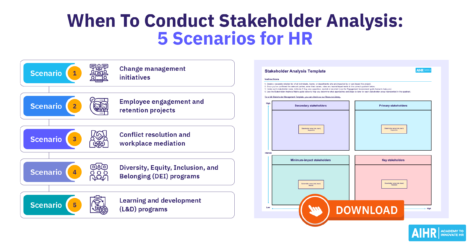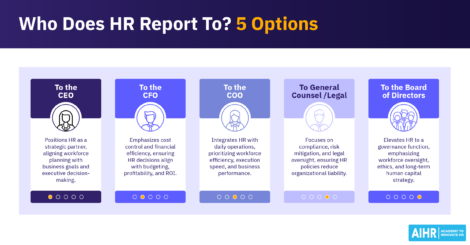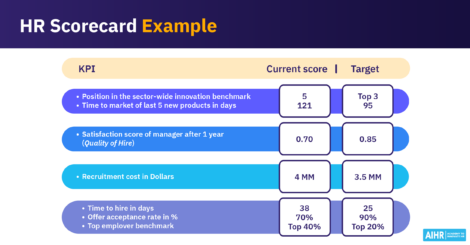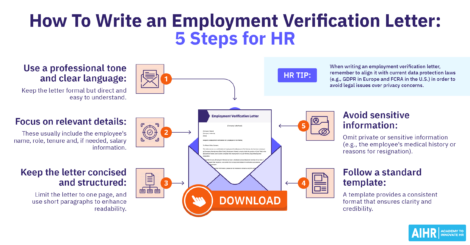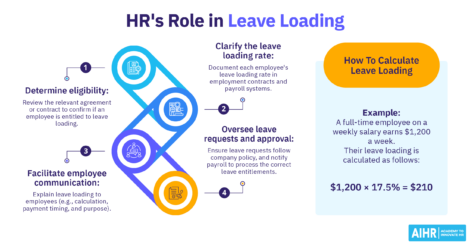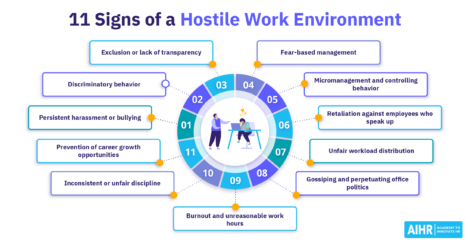HR Canvas: A Practical Guide + Template for HR Leaders
The beauty of a blank canvas lies in its countless possibilities, encouraging us to let our imagination run free and be creative. To a certain extent, the same goes for the HR canvas, offering HR teams a way to paint a unique picture of their service delivery.

The HR canvas is an excellent tool for helping HR practitioners adapt their service delivery model to reflect today’s continuously evolving organizational demands, business models, and employee needs in an agile way.
This article examines the HR business model canvas and why you should use it. We discuss the framework’s key components, how to fill in the canvas, and a practical example. We also provide a downloadable and editable HR canvas template. Let’s go!
Contents
What is the HR canvas?
Why should you use the HR canvas in your HR department?
Key components of the HR canvas
How to use the HR canvas in practice: An example
Best practices for using HR canvas
HR canvas template
What is the HR canvas?
The HR canvas – or, in full, the HR Service Delivery Model Canvas – is a strategic HR management tool designed to solve the problem of many businesses not seeing the alignment of HR solutions to their key business challenges.
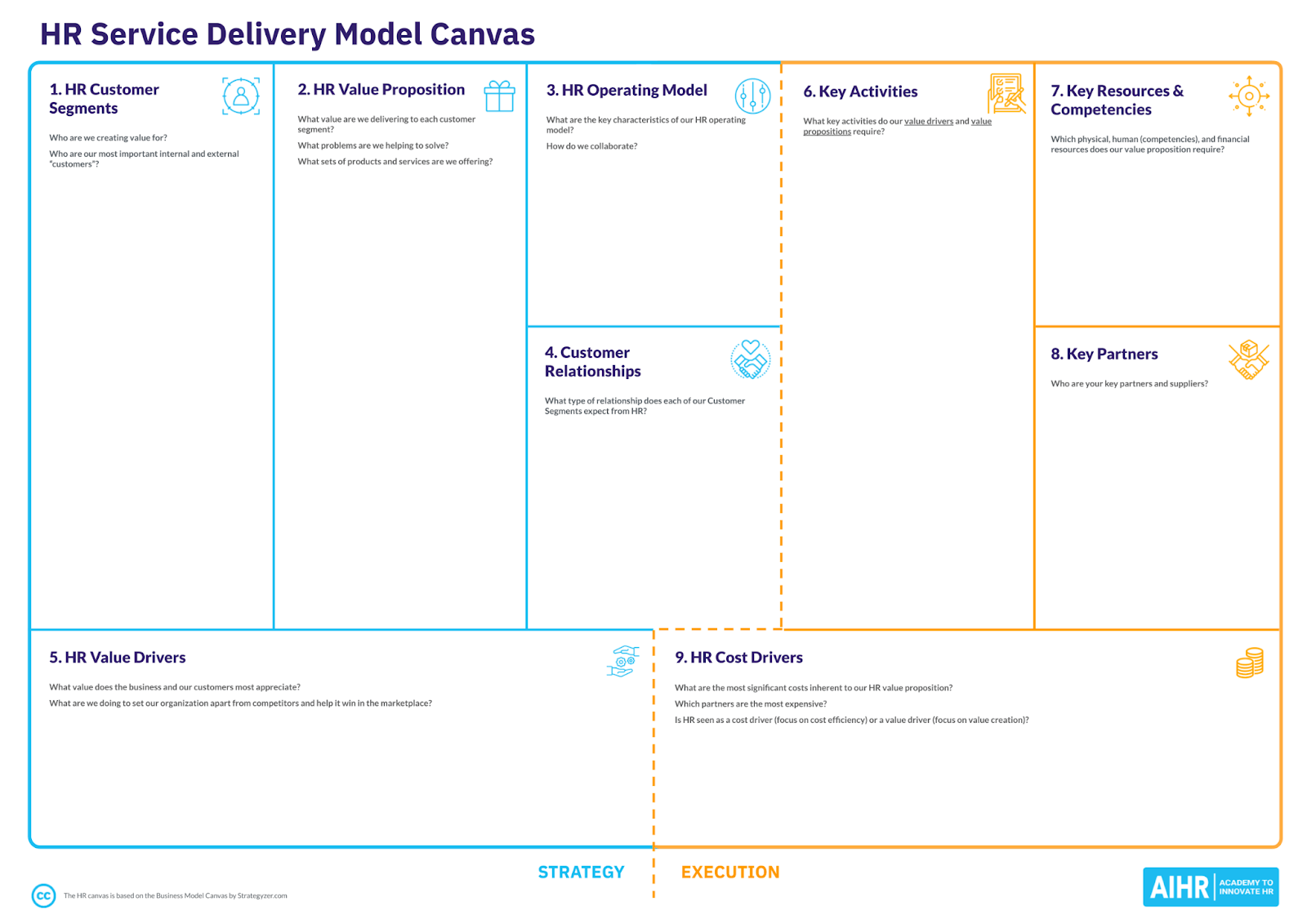
Developed by AIHR’s Erik van Vulpen and Dr. Dieter Veldsman, it is inspired by the Business Model Canvas, a management tool widely used by startup founders and executive boards alike. It helps summarize all critical areas of business in a comprehensive yet clear one-pager.
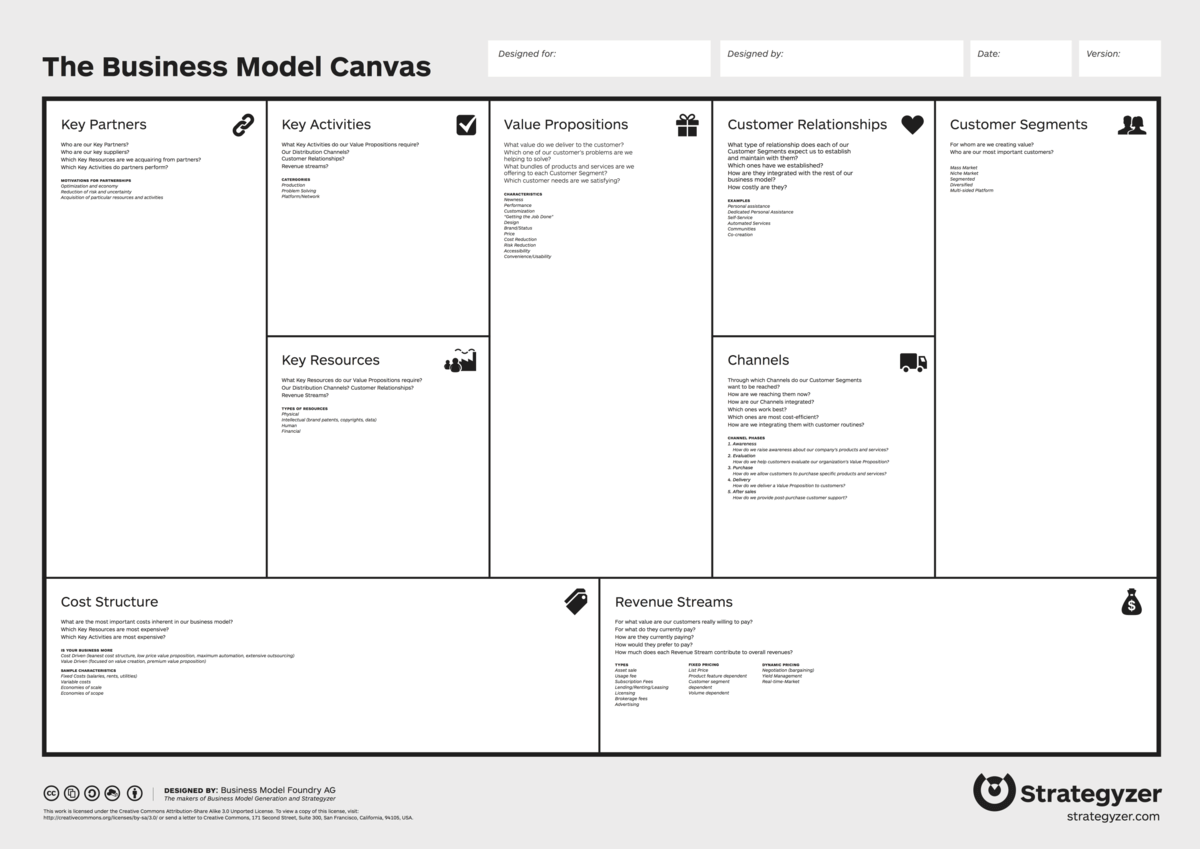
Similarly, the HR canvas provides a clear strategic overview of the HR organization, its customers, value proposition, activities, strategic differentiators, and cost drivers. Clarifying these elements will help HR professionals define their service delivery while articulating HR’s strategic impact and value. In other words, the HR canvas allows HR to align with the business through a common language. HR practitioners can also use the tool to improve internal HR alignment and maintain focus.
The HR canvas helps answer questions such as ‘How should we organize ourselves?’, ‘What (business) problems are we trying to solve?’ and ‘What value are we delivering?’ Discussing these questions using a structured framework helps create the internal alignment required for successful HR service delivery.
Why should you use the HR canvas in your HR department?
One of HR’s biggest challenges today is its lack of strategic impact. Often referred to as not having a ‘seat at the table,’ HR struggles to lead strategic people conversations and show its added value to the business.
As mentioned above, the problem here is not that the business doesn’t want HR to be a strategic player. Rather, the company does not see the alignment of the HR solutions to its key challenges. Using the HR canvas can help solve this problem.
Key reasons for HR to use this tool include:
- Driving strategic contribution: The HR canvas can help HR move beyond administration by clearly linking people initiatives to business challenges and goals, making HR a true strategic partner.
- Providing a clear blueprint for HR operations: As discussed earlier, the canvas maps out HR operations, ensuring a strong focus on strategic priorities.
- Creates a shared framework for your HR team: The HR canvas model aligns HR teams for better collaboration and consistency.
- Helps demonstrate impact: We mentioned this already, but using the HR canvas demonstrates HR’s value and impact on the organization’s leadership.
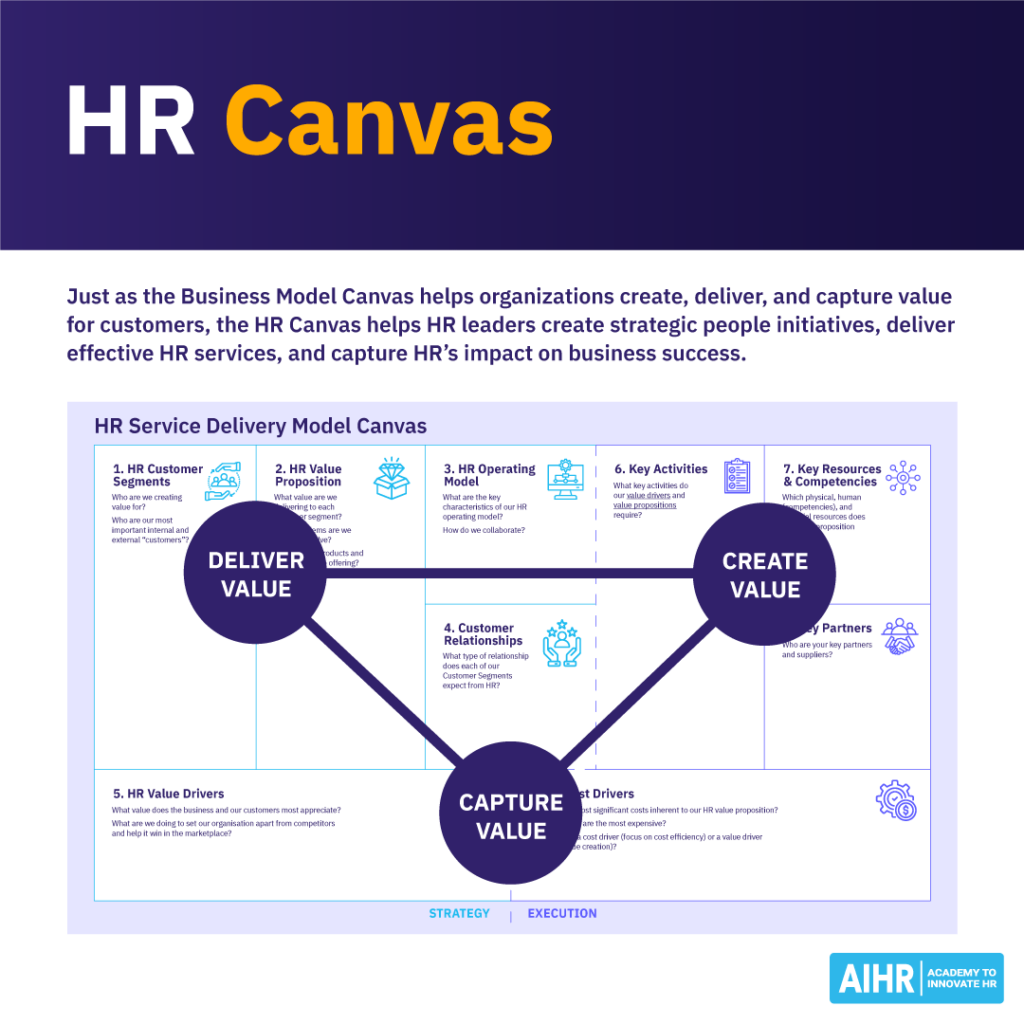
Key components of the HR canvas
The HR canvas consists of nine distinct fields. There is a sequential order in which the fields should be filled in:
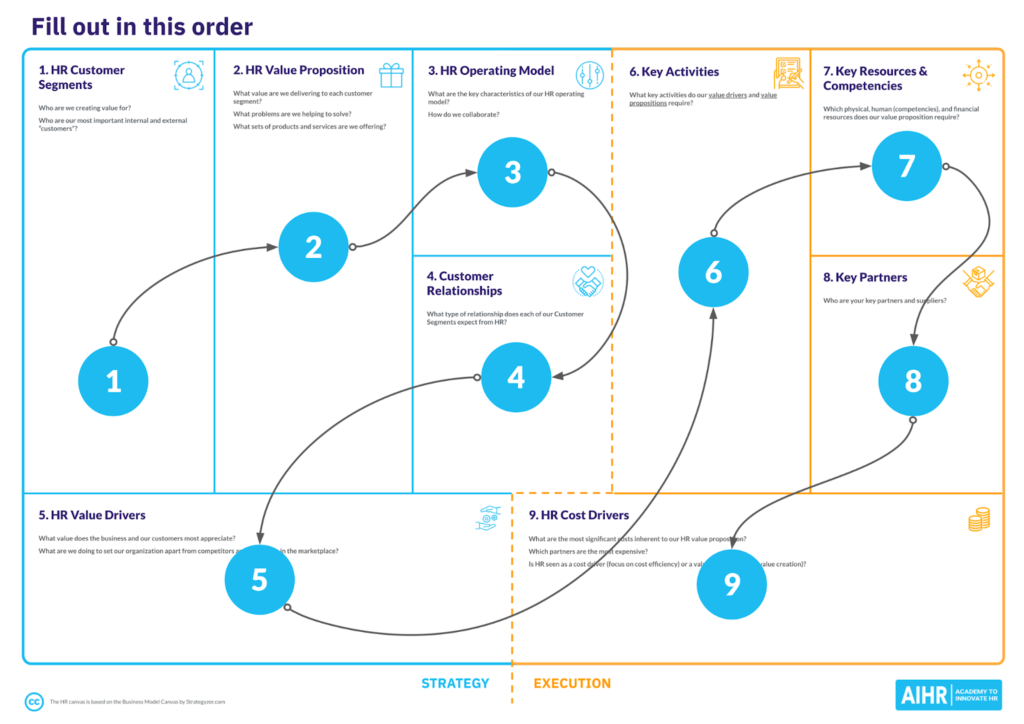
For each component, you can ask yourself a couple of questions that will help you fill in the field. We’ll go over all nine fields in order of completion.
1. Core customer segments
Main question: Who are your core customer groups?
This refers to all relevant stakeholder groups in and outside the organization for which HR is (or should be) creating value. It includes:
- Employees
- Managers
- Customers
- Shareholders
- Employee representation groups
- Etc.
The aim here is to create value for external stakeholders (e.g., customers and shareholders) while also creating value for internal stakeholders (e.g., employees, line managers, and so on).
Additional questions to answer here are:
- Who are we creating value for?
- Who are our most important external customers?
- Who are our most important internal customers?
2. HR value proposition
Main question: What value do you provide for your customers?
For each customer segment, you have a specific value proposition. These are the bundles of HR practices that create value for these customers.
Questions to answer here include:
- What do our Customer Segments expect from us as a function?
- What is HR’s key contribution to each Customer Segment?
- What customer problems are we helping to solve?
- What needs of our customers are we meeting?
- What sets of products and services are we offering for each Customer Segment?
3. HR operating model
Main question: How are your services delivered to your customer segments?
This is about how you create value and deliver the value proposition to your customers.
Questions to answer here are:
- How do we shape the HR operating model?
- How are we reaching and servicing our customer segments?
- How do we collaborate?
- How do we ensure both operational excellence and strategic added value?
- Do we have HR service evaluation processes in place?
4. Customer relationships
Main question: How do you manage your customers and continuously add value?
This focuses on managing customer relationships and helps to determine whether the HR department is investing in the right relationships and managing them adequately.
Questions to answer here include:
- What type of relationship does each of our Customer Segments expect us to establish and maintain with them?
- Are we maintaining the right relationships?
- Are we continuously providing additional value?
5. HR value drivers
Main question: What strategic value does HR drive for the business?
This is arguably the most challenging part of the HR Canvas to complete, as it is often one of HR’s weak spots. Don’t just list your HR activities; ask line managers and senior executives how HR contributes to the organization’s competitive advantage.
Here some of the questions to answer are:
- What are the HR activities for which the business would pay a premium?
- How does HR drive value for the business?
- How do we build unique capabilities and contribute to strategic advantage?
- What value does the business most appreciate?
- Which strategic capabilities are we delivering to help the business win in the marketplace?
Equip your HR team to drive business impact
A well-structured HR canvas provides clarity on HR’s role in achieving business goals. But without the right expertise, even the best HR frameworks can fall short. HR professionals need the right skills to bring them to life.
AIHR for Teams helps equip your team with skills to apply, refine, and execute HR strategies effectively and turn HR plans into measurable business results.
6. Key activities
Main question: What activities do we need to execute to deliver on our value proposition?
This list focuses on the core activities of HR required to realize the value proposition and value drivers.
Consider the following questions here:
- What activities does our value proposition require?
- How do we strategically differentiate from the competition?
- Which strategic capabilities help us deliver on our value proposition?
7. Key resources
Main question: Which resources does our value proposition require?
Executing effective HR service delivery requires certain physical, human, and financial resources. A match between the available resources and the value proposition is key to successful HR service delivery.
Questions to answer here include:
- Which physical, human, and financial resources does our value proposition require?
- Which competencies enable us to deliver our value proposition and HR activities?
- Which competencies would enable us to drive more value?
- Which competencies do line managers need to deliver on HR’s value proposition?
8. Key partners
Main question: Which partners are required to deliver on the value proposition?
These partners include vendors, consultancies, and upskilling partners regularly used to optimize HR service delivery.
Consider answering these questions:
- Who are your key partners and suppliers?
- What services and resources are we acquiring from partners?
9. Cost drivers
Main question: Which activities are the most expensive?
Cost drivers form the final box, which helps balance the activities required to fulfill the value proposition with the available resources.
Questions to ask and answer here are:
- Which key activities are the most expensive?
- What are the most significant costs inherent to our HR value proposition?
- Which partners are the most expensive?
- Where are the most significant opportunities for digitization and automation?
- Is HR seen as a cost driver (focus on cost efficiency) or a value driver (focus on value creation)?
The HR canvas isn’t something that stands alone. This has two consequences that are good to consider before filling in this document. Firstly, the organizational strategy and key business priorities are the starting point – or input – for the HR canvas. Based on these priorities, your Customer Segments and the value you produce for them will shift.
Secondly, once the nine HR canvas dimensions are filled in, the HR department can use them to define their key performance indicators. This enables you to measure and assess:
- How well the HR organization is doing
- If it is delivering on its priorities
- And, as a result, if it contributes to the business strategy.
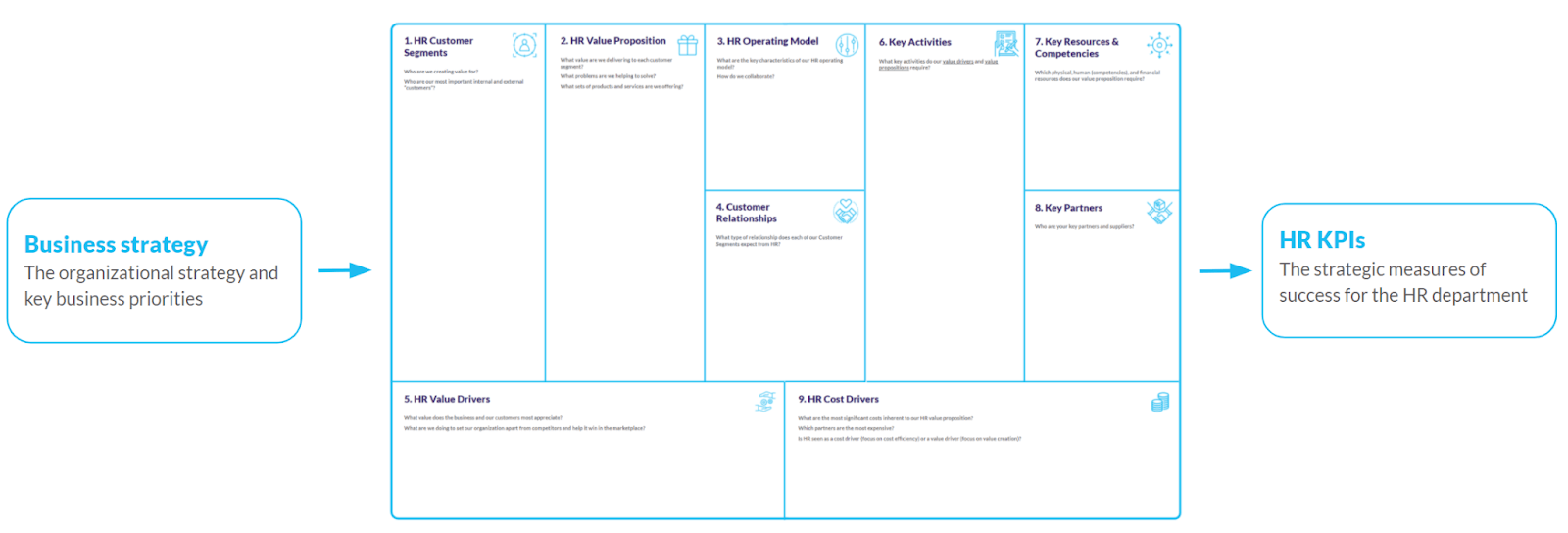
How to use the HR canvas in practice: An example
Let’s illustrate how the HR canvas model works with an example.
EdgeDotGrow is a founder-led SaaS company with 50 full-time employees, a recruiter, and a newly appointed HR manager. The company’s strategic priorities are:
- Retention of existing clients
- Scaling the organization
- Building the next version of the software product
- Establishing foundation governance and business processes required to sustain its fast growth.
The HR manager spoke with the relevant stakeholders during their onboarding and filled in the HR canvas. Core customer segments include the investors, founders, management team, employees, and critical third-party vendors.
After interviewing the different HR customer segments, the HR value proposition and operating model were defined. The HR manager aimed to increase self-service for the company’s employees. Key activities included attraction, employer branding, and establishing standard policies and processes.
The most significant value driver was having talent ready whenever the organization needed to expand. This was going to be done by:
- Building a strong employer brand
- Optimizing the recruitment cycle while complying with basic norms and;
- Ensuring the workforce stays motivated by providing a great employee experience.
The HR manager completed the canvas based on this information, identifying HR’s core customers, the value proposition, operating model, value drivers, activities, partners, and resources. The process resulted in the following overview:
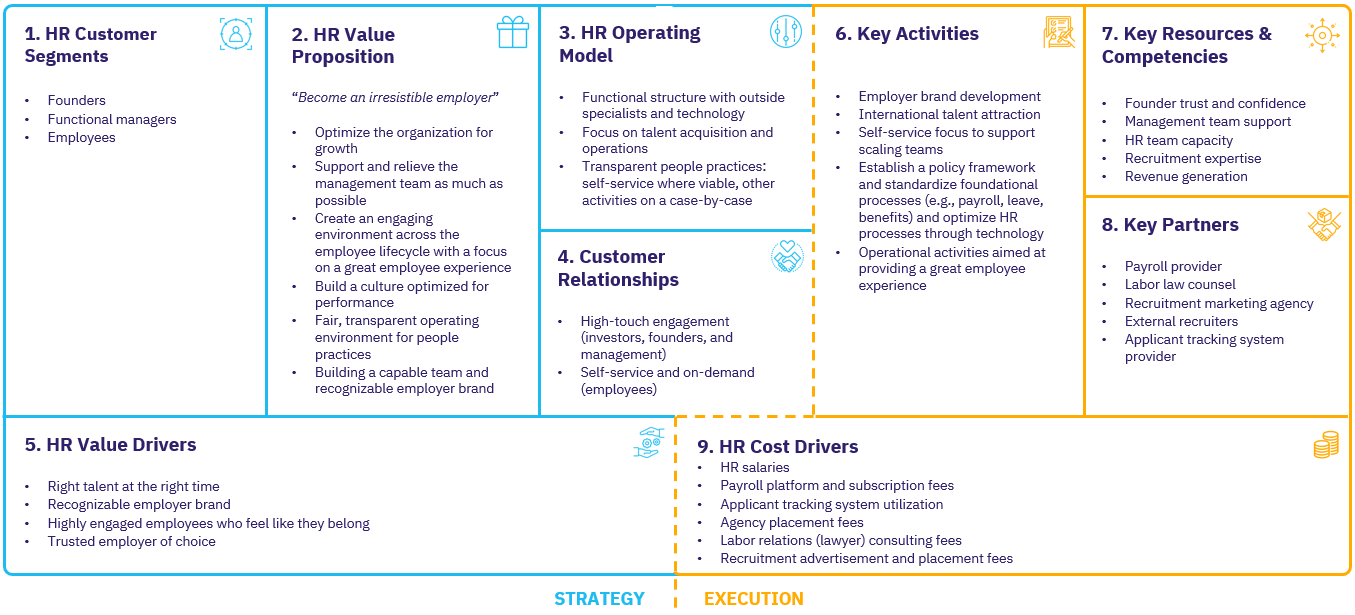
Based on this canvas, the HR manager could define their HR KPIs. The most important ones, in this case, were the time to fill in days, KPIs related to employer branding, and the employee Net Promoter Score (eNPS).
This example shows how the HR canvas can provide a clear direction for the HR manager and their team, including the actions they need to take to reach their goals and the partners and resources they need to be successful.
Best practices for using HR canvas
The HR canvas is a management tool that helps to strategically map and define HR’s contribution to the various business stakeholders. Depending on the number of people involved, filling in the tool can take anywhere from thirty minutes to multiple days, but it will pay off quickly.
Here are a few elements for HR to keep in mind while filling in the canvas to make the most out of it:
- Start with the business in mind: Anchor your HR strategy with the organization’s overarching goals. Identify key business challenges and ensure HR initiatives directly address them.
- Involve and align with key stakeholders: Collaborate with senior leadership, department heads, and HR team members. Gather insights from employees to ensure HR initiatives align with workforce needs.
- Keep it simple and actionable: Focus on clear, concise inputs for each section of the canvas. Stick to key priorities rather than listing every HR activity.
- Upon completion, check back: After completing the canvas, review it with key stakeholders to confirm HR’s contribution aligns with their needs and to prevent scope creep.
- Review and update regularly: Approach the canvas as a living document that guides strategy rather than a one-time exercise. Revisit the canvas periodically (e.g., quarterly or annually) to reflect changes in business strategy. Adjust priorities based on new challenges, workforce shifts, or leadership direction.
- Link HR metrics to the canvas: Set your HR KPIs and metrics based on the HR canvas. For instance, if your HR value proposition focuses on improving retention, you should track turnover rates, employee engagement scores, and internal mobility. If your key activities include leadership development, measure participation rates, promotion rates, and leadership effectiveness scores.
HR canvas template
We have created an editable HR Service Delivery Model Canvas template to help you get started and make your work easier.
A final word
Despite the business often not fully seeing the alignment of HR solutions to its key challenges, HR’s contribution to business value is slowly but surely being recognized more and more across the board.
For businesses to thrive in the current (economic) climate, they need to embrace the power of HR and, through it, the power of their employees. However, this move will have no real positive impact unless HR itself is ready and willing to align with the ever-changing business it serves. The HR canvas is an indispensable tool to do so.
Learn more
Related articles
Are you ready for the future of HR?
Learn modern and relevant HR skills, online








